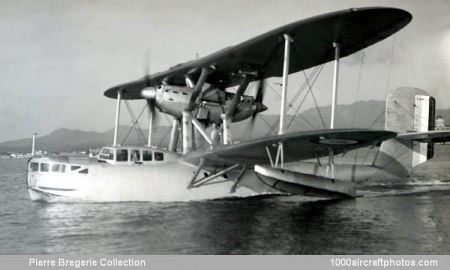The CAMS 110 maritime reconnaissance biplane flying boat had wooden wings and a metal hull, and was powered by two 860 hp Hispano-Suiza 12 Ydrs engines placed in in tandem, driving a push and a pull propeller. Its armament consisted of four 0.295 in (7.5 mm) Darne machine guns mounted in side ports, and a bomb load of 2,25 lb (1,000 kg) could be carried. Yves-Marie Lantz flew the aircraft on its first flight from Sartrouville in July 1934. Despite excellent performance the French Navy did not order the type.
The aircraft was acquired by the État Français (French government) and was registered as F-ANVX on June 3, 1935, subsequently it was demilitarized, and eventually prepared for transatlantic flight. However, there had been many fatal accidents on such flights, and after the disappearance of Jean Mermoz and his crew on December 7, 1936, the French Government prohibited these flights.
Reregistered F-AOCP the aircraft was used as an equipment test bed, and in May 1939, it was militarized again and assigned to French Navy Escadrille 3S4 at Berre. It was destroyed when France entered WW II. Note that sometime between 1934 and 1939, the original trapezoidal shaped tail had been replaced by a square and enlarged one, while the upper cockpit had been enlarged also, and a number of side windows had been deleted.
Span: 73 ft 9.8 in (22.50 m)
Length: 53 ft 5.7 in (16.30 m)
Height: 19 ft 8.2 in (6.00 m)
Wing area: 1238.39 sq.ft (115.05 sq.m)
Weight empty: 12,170 lb (5,520 kg)
Loaded weight: 20,393 lb (9,250 kg)
Max speed: 149 mph (240 kmh)
Service ceiling: 21,325 ft (6,500 m)
Range: 1,678 mls (2,700 km)
